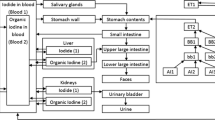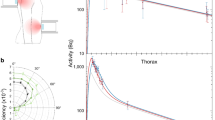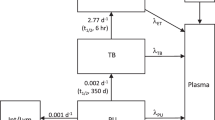Abstract
Literature data from in vivo chest measurements and urinary excretion rates of individuals exposed to U3O8 and UO2 were used to compare the results predicted by different models with empirical observations in humans. As a result the use of the respiratory tract model proposed in ICRP Publication 66 with its default absorption parameters underestimates urinary excretion of inhaled U3O8 and UO2. The new respiratory tract model also overpredicts the Fecal/Urine activity ratio, independently of the systemic model. For U3O8 and UO2 the choice of systemic model has very little influence on the predicted urinary excretion of inhaled compounds. On the other way, the choice of the respiratory tract model does influence the predicted urinary excretion significantly. In this work specific absorption parameters for U3O8 and UO2 were derived to be used in the respiratory tract model proposed in ICRP Publication 66. The predicted biokinetics of these compounds were compared with those derived for Type M and Type S compounds of uranium.
Similar content being viewed by others
References
International Commission on Radiological Protection, Human Respiratory Tract Model for Radiological Protection, Report of a Task Group of the International Commission on Radiological Protection, ICRP Publication 66, Pergamon Press, 1994.
International Commission on Radiological Protection, Limits for Intakes of Radionuclides by Workers, ICRP Publication 30, Pergamon Press, 1979.
E. Ansoborlo, M. H. Henge-Napoli, M. Donnadieu-Claraz, M. Roy, P. Pihet, Radiat. Prot. Dosim., 53, 167 (1994) 163.
International Commission on Radiological Protection. Age-dependent doses to members of the public from intake of radionuclides: Part 3, Ingestion Dose Coefficients; ICRP Publication 69, Elsevier Science Ltd., Oxford, 1995.
M. E. Wrenn, L. Bertelli, P. W. Durbin, N. P. Singh, J. L. Lipsziein, K. F. Eckerman, Radiat. Prot. Dosim., 53 (1994) 255.
L. Bertelli, J. L. Lipsztein, Radiat. Prot. Dosim., 18 (1987) 209.
L. Bertelli, M. C. Lourenco, C. A. N. Oliveira, J. L. Lipsztein, An analytical mathematical method to calculate activity in body organs and excreta, Proc. Intem. Seminar of Application of Computer Technology to Radiation Protection, IAEA, Bled, Yugoslavia, 22–26 June 1987, Jozef Stefan Institute, 1989.
L. Bertelli, M. E. Wrenn, Radiat. Prot. Dosim., 53 (1994) 277.
M. R. Avadhanula, R. M. Chatterjee, G. J. Healey, F. J. Horvath, M. P. Measures, H. Stocker, C. Pomroy, J. R. Johnson, D. W. Dunford, Canadian uranium fuel fabrication study: I. intake, retention and excretion monitoring results, II. comparison of results with metabolic models, Intern. Symp. on the Assessment of Radioactive Contamination in Man, International Atomic Energy Agency, IAEA-SM-276/51, 1985.
M. R. Quastel, H. Taniguchi, T. R. Overton, J. D. Abbatt, Health Phys., 18 (1970) 233.
H. Schieferdecker, H. Dilger, H. Doerfel, W. Rudolph, R. Anton, Health Phys., 48 (1985) 29.
K. S. Thind, Health Phys., 53 (1987) 59
BMDP Statistical Software, Dixon W. J., Berkeley-Los Angeles-Oxford, University of California Press, 1992.
D. R. Fisher, P. O. Jackson, G. G. Brodaczynski, R. I. Scherpelz, Health Phys., 45 (1983) 617.
M. E. Wrenn, H. Ruth, D. Burleigh, N. P. Singh, J. Radioanal. Nucl. Chem., 156 (1992) 407.
M. E. D. Bains, P. W. J. Rowbury, Health Phys., 16 (1969) 449.
N. B. Schultz, Inhalation cases of enriched insoluble uranium oxides, Proc. 1st Intern. Congress of Radiation Protection, Pt. 2,W. S. Snyder, et al. (Eds), Pergamon Press, Oxford, 1968.
E. Ansoborlo, P. Berard, J. Chalabreysse, Radiat. Prot. Dosim., 26 (1989) 101.
C. M. West, L. M. Scott, Health Phys., 12 (1966) 1545.
J. Chalabreysse, P. Beau, C. Chevalier, L. Jeanmaire, G. Bataller, P. Berard, B. Gibert, Radiat. Prot. Dosim., 26 (1989) 49.
International Commission on Radiological Protection. Dose Coefficients for Intakes of Radionuclides by Workers, ICRP Publication 68, Elsevier Science Ltd., Oxford, 1994.
G. N. Stradling, J. C. Moody, J. Radioanal. Nucl. Chem., 197 (1995) 309.
Author information
Authors and Affiliations
Rights and permissions
About this article
Cite this article
Bertelli, L., Puerta, A., Wrenn, M.E. et al. Specific absorption parameters for uranium octoxide and dioxide applicable to the ICRP Publication 66 respiratory tract model. J Radioanal Nucl Chem 226, 233–239 (1997). https://doi.org/10.1007/BF02063654
Received:
Issue Date:
DOI: https://doi.org/10.1007/BF02063654




